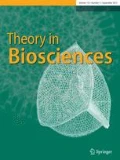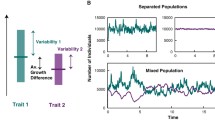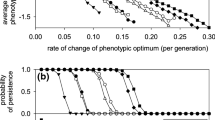Abstract
It was shown by Gillespie [1974. Am. Nat. 108, 145–151], that if two genotypes produce the same average number of offspring on but have a different variance associated within each generation, the genotype with a lower variance will have a higher effective fitness. Specifically, the effective fitness is {ei65-1}, where w is the mean fitness, {ei65-2} is the variance in offspring number, and N is the total population size. The model also predicts that if a strategy has a higher arithmetic mean fitness and a higher variance than the competitor, the outcome of selection will depend on the population size (with larger population sizes favoring the highvariance, high-mean genotype). This suggests that for metapopulation sizes favoring the high-variance, high-mean genotype). This suggests that for metapopulations with large numbers of (relatively) small demes, a strategy with lower variance and lower mean may be favored if the migration rate is low while higher migration rates (consistent with a larger effective population size) favor the opposite strategy. Individual-based simulation confirms that this is indeed the case for an island model of migration, though the effect of migration differs greatly depending on whether migration precedes or follows selection. It is noted in the appendix that while Gillespie [1974. Am. Nat. 108, 145–151] does seem to be heuristically accurate, it is not clear that the definition of effective fitness follows from his derivation.
Similar content being viewed by others
References
Bernoulli, D., 1738. Exposition of a new theory on the measurement of risk. Econometrica 22, 23–36 (transl. and reprinted, 1954).
Charnov, E.L., Schaffer, W.M., 1973. Lif history consequences of natural selection: Cole’s result revisited. Am. Nat. 107, 791–793.
Doebeli, M., Koella, J., 2001. Sex and population dynamics. Proc. R. Soc. London B 257, 16–23.
Ewens, W.J., 2003. Mathematical Population Genetics. Springer, New York.
Feller, W., 1951. Diffusion processes in genetics. Proceedings of the Second Berkeley Symposium on Mathematical Statistics and Probability, pp. 227–246.
Gillespie, J.H., 1973. Natural selection for within-generation variance in offspring number. Genetics 76, 601–606.
Gillespie, J.H., 1974. Polymorphism in patchy environments. Am. Nat. 108, 145–151.
Gillespie, J.H., 1977. Natural selection for variance in offspring numbers: a new evolutionary principle. Am. Nat. 111, 1010–1014.
Haldane, J.B.S., Jayakar, S.D., 1963. Polymorphism due to selection of varying directions. J. Genet. 58, 237–242.
Hanski, I., Gilpin, M., 1991. Metapopulation dynamics: brief history and conceptual domain. Biol. J. Linnean Soc. 42, 3–16.
Keown, A.J., Martin, J.W., Petty, W.D., Scott, D.F., 2001. Financial Management: Principlesand Applications, ninth ed. Prentice Hall, New York.
Kimura, M., 1964. The diffusion model in population genetics. J. Appl. Probab. 1, 177–232.
Levene, H., 1953. Genetic equilibrium when more than one niche is available. Am. Nat. 87, 311–313.
Levins, R., 1970. Extinction. In: Gestenhaber, M. (Ed.), Some Mathematical Problems in Biology. American Mathematical Society, Providence, RI, pp. 77–107.
Luethy, R., 2000. Population dynamics and the evolution of bet-hedging strategies in stochastic environments, Unpublished.
Proulx, S., 2000. The ESS under spatial variation with applications to sex allocation. Theor. Popul. Biol. 58, 33–47.
Schaffer, W.M., 1974. Optimal reproductive effort in fluctuating environments. Am. Nat. 108, 783–790.
Stearns, S.C., 2000. Daniel Bernoulli (1783): evolution and economics under risk. J. Biosci. 25, 221–228.
Stearns, S.C., Crandall, R.E., 1981. Bet-hedging and persistence as adaptations for colonizers. In: Scudder, G.G.E., Reveal, J.L. (Eds.), Evolution Today. Hunt Institute, Philadelphia, PA.
Tilman, D., Knops, J., Wedin, D., Reich, P., Ritchie, M., Seimann, E., 1997. The influence of functional diversity and composition of ecosystem processes. Science 277, 1300–1302.
Wallace, B., 1968. Topics in Population Genetics. W.W. Norton and Company, New York.
Author information
Authors and Affiliations
Corresponding author
Rights and permissions
About this article
Cite this article
Shpak, M. Evolution of variance in offspring number: The effects of population size and migration. Theory Biosci. 124, 65–85 (2005). https://doi.org/10.1016/j.thbio.2005.05.003
Received:
Accepted:
Issue Date:
DOI: https://doi.org/10.1016/j.thbio.2005.05.003




